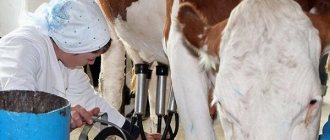Milking machine and its structure
The milking machine is quite simple. It consists of the following components:
- Four teat cups
- Milk and air lines
- Milk collection container
- Pump
- Collector
- Pulsator (available in machines with a pulsator. If a milking machine for cows has a piston pump, then it does not have a pulsator, since the role of a pulsator is played by the pump and valves in the can and pump. They open and close in connection with the direction of movement of the piston).
One of the main pieces of equipment is the milking cups. They have a rather complex structure. The glasses are based on hard glasses (made of metal or plastic), with rubber tubes located inside. A sealed inter-wall chamber is formed between the rigid glass and the rubber tubes.
Two tubes are attached to the glass.
One tube connects the glass to the nipple (internal) chamber. This tube is needed to suck out milk. The second tube is connected to the interwall chamber. This tube is needed to create a vacuum pulsation. The milking machine works according to the following principle:
- A vacuum (low pressure) is stably maintained in the nipple chamber.
- The compression of the nipple occurs with the help of vacuum pulsation in the interwall chamber.
- During the period when the same low pressure is created in these two chambers, milk flows from the nipple.
- The milk enters the collector, and then into a can or other prepared container.
- During the period when the pressure in the interwall chamber rises to atmospheric pressure, the rubber tube contracts, compresses the nipple and the milk stops flowing.
Did you know? Modern milking machines allow you to milk up to 100 cows per hour; an experienced milkmaid can milk only five cows manually in the same time.
This operating principle is typical for push-pull units. The pulsation frequency during milking ranges from 45 to 60 beats per minute. The ratio of the duration of the suction stroke to the compression process ranges from 50 to 50 to 85 to 15, and in modern equipment it is 60 to 40.
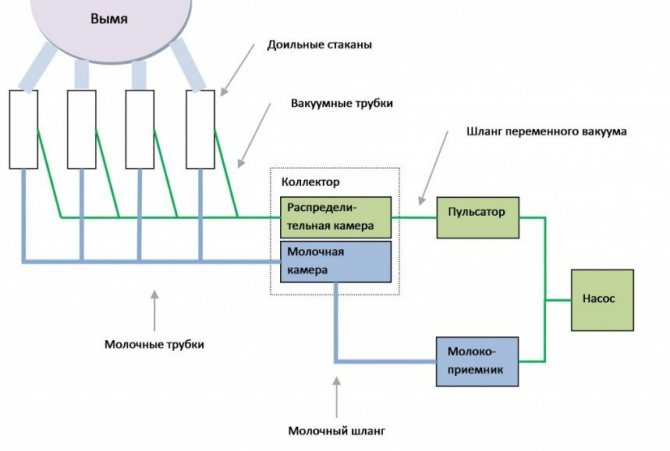
Classification and types of milking machines
Milking machines have the following components in their design: electric motors, vacuum pumps for the milking machine, vacuum gauges, vacuum cylinders, vacuum pipelines, milking buckets.
The milking machines themselves differ in the following positions:
- two- or three-stroke milking technology;
- single- or double-chamber milking cups;
- the number of simultaneously milked animals;
- collecting milk in a container or pipeline.
Milking machines can be classified only by their technical characteristics. Today, the vast majority of milking devices are vacuum milking systems, which have the same operating principle. They differ from each other only in the following parameters:
- Milking method: in 2 or 3 strokes. Modern compact milking machines are most often push-pull.
- Design of milking cups: single- and double-chamber. The most common are two-chamber glasses.
- Number of animals served at the same time. Compact milking machines are most often designed for simultaneous milking of 1/2 cows/sheep/goats. Large milking machines can milk dozens of animals at the same time.
- Milk collection: in a can or through pipelines. In compact milking machines, milk usually enters a can, and piping is used only in large stationary installations.
However, the greatest interest is in the classification of milking machines according to the method of creating pulsations of air pressure (vacuum) in the milking cups. In the modern world there are two main ways:
- using a pulsator (this uses a centrifugal pump that creates a constant vacuum).
- using a piston pump (in this case, the role of a pulsator is played by a pump that ensures a change in pressure in the glasses with a certain frequency).
In modern mobile milking machines, both methods are used, but each of them has both its advantages and disadvantages. For example, the use of a pulsator complicates the design of the apparatus and increases its cost, but it provides better milking quality.
Kinds
The classification of milking machines can be made only according to technical characteristics. Most of them are vacuum. Such installations have the same operating principle, the only difference is in the details.
Milking method
Depending on the milking method, the machine can be suction or squeeze .
Vacuum pumps are used in suction-type installations. Such equipment is manufactured on an industrial scale and has a number of advantages:
- Without nipple rubber
- More gentle on the udder and teats
The equipment works on the following principle: using a pump, pressure is created in glasses (placed on the nipples), which sucks milk out of the udder.
When air replaces the vacuum, the pressure increases and the nipples are compressed by the rubber tube, stopping the milk supply. With the help of pressure differences, the process approaches natural milking. In squeeze-type milking machines, excess pressure is added to the vacuum. These types of equipment are produced individually.
Milking discontinuity
Depending on the milking method, there are permanent, two- and three-act installations.
Permanent milking machines operate continuously - the process of milk suction takes place under the constant outflow of milk from the udder. Such equipment does not have a standby mode (rest phase). Such devices are not physiologically convenient for cows.
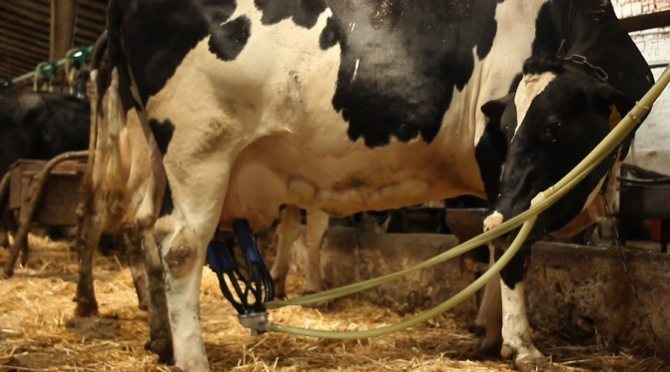
Push-pull devices operate in two modes - sucking and compression. In three-act plays there is also a third mode - rest.
Modern devices are predominantly two-act. Three-acts are more powerful, but two-acts are lighter. And if the device is not stationary and will need to be worn, then it is better to choose a two-act installation.
Transportation of milk
Also, depending on the type of milking machine, milk can be collected in a can or through pipelines. If it is a compact device, then the milk goes into the can. Such devices are well suited for small farming. Devices that are connected to pipelines are used on farms with large livestock.
Application area
Such a unit can be useful both in a small household and on a large farm. In the first case, it is enough to buy a milking machine with two strokes. Their capabilities are enough to milk two cows or goats at once, which is already a considerable help. If we are talking about a farm, then in this case powerful installations are chosen. However, they make a lot of noise and are large in size, so their installation requires a special room.
The use of such units in the household today is a necessity. This is due to the fact that the milk produced using the machine is much purer than that which was obtained manually. In addition, the presence of technology allows you to reduce labor costs, reduce time, and also increase profits.
It offers to select the optimal device and purchase it on favorable terms. The offered equipment is characterized by an optimal price-quality ratio, durability and ease of maintenance.
How to choose a milking machine
There are a large number of milking machines, since not a single farm can do without automating the process of obtaining milk. All cars differ from each other in configuration, power, dimensions and are not a new category.
However, all devices operate on the same principle and contain a vacuum pump with pressure. The choice depends on many individual requirements. An important criterion is how the milk is collected and how many cows can be milked at the same time.
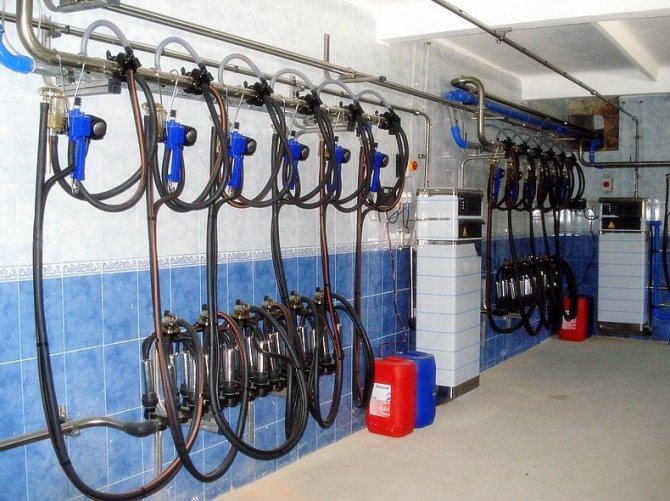
Required indicators
It is necessary to take into account the technical characteristics of the machine and, based on this, classify the equipment. Livestock breeders divide milking machines into main types: individual and group.
There are three types of vacuum pumps in milking machines:
- A diaphragm pump is the cheapest option and is not designed for heavy loads. You can milk no more than three cows at a time. Such a vacuum pump would be appropriate in machines on small farms.
- The piston pump is somewhat more powerful than the previous one, but also has disadvantages. Animals may be negatively affected because this type of pump is very noisy and heats up quickly. It should also be noted that the device equipped with such a pump is large.
- The rotary pump is quieter than the previous ones. This option is ideal if your animals are afraid of loud noises and you are concerned that the milking machine may frighten them. The rotary pump is of dry and oil type.
Typically, farms use three- and two-act milking machines.
The types of machines differ in that in three-act compared to two-act machines, in addition to compression and sucking, there is also a resting stroke. According to the type of milk collection, the equipment differs into machines that collect milk through pipes or into a can. The small milking machine is suitable for collecting milk into a can, so it can be used for a small number of cows. Large stationary installations collect milk through pipes; such equipment is used on large farms, where the amount of milk collected is an order of magnitude higher.

Did you know? Because the proteins in cow's milk bind to toxins in the body, it is recommended to chemical workers because it effectively removes toxins. Milk will also help remove harmful substances from the body after drinking alcohol.
You can choose a device based on the principle of possible movement. Machines can be mobile or stationary. For large farms, mobile ones are suitable, which resemble a cart with wheels, a support, milking buckets and a pump.
The ease of moving the device means it can serve many more cows. Moving such equipment will take a few minutes and does not require much effort.
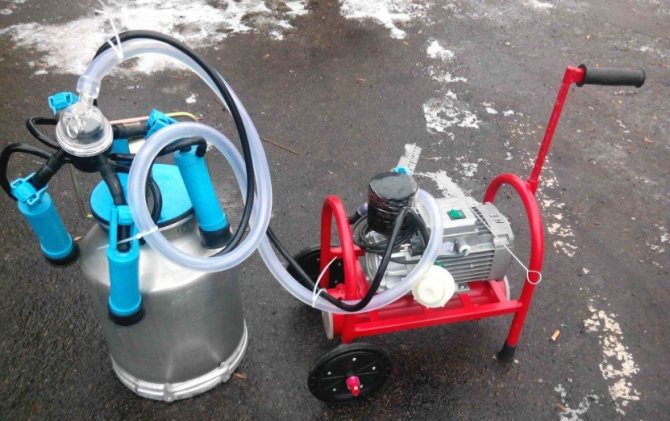
What you can ignore
Regardless of the type of installation chosen, the speed and quality of milking compared to manual milking will increase by an order of magnitude. Any device will be ideal for your cows.
The main thing in keeping cows is a properly combined diet - it should contain both rough dry feed (hay, straw), juicy feed (silage, apple cake), and root vegetables (potatoes, beets, carrots, Jerusalem artichoke), as well as sunflower additives that improve the quality of milk oil cake, meal, oats, barley, wheat.
Also, do not pay attention to the complexity of mastering different types of installations, since modern milking machines, regardless of type and manufacturer, are quite easy to master even for a non-specialist. You just need to read the operating instructions and follow the necessary hygiene rules.
Also, in modern installations you should not pay attention to the manufacturer, since domestic developers produce cars no worse than foreign ones.
How to milk a cow with a machine
To obtain high milk yields at low physical costs, machine milking is widely used. For the success of such milking, you must strictly follow the instructions on how to properly milk a cow with a milking machine, as well as the rules for handling cows. Make sure milking machines are in good working order.
The milking machine works on the following principle: rarefied air flows through a special hose from the vacuum line into the pulsator, then through the variable vacuum hose directly into the inter-wall space. The result is a sucking stroke, the vacuum acts all the time in the nipple chamber of the teat cup.
Before transferring cows to machine milking, you need to inspect the cow and her udder. It is necessary to check for mastitis in the udder and teats, since cows with the disease are milked by hand. Machine milking begins only after the animal has completely recovered.
The speed and completeness of milking animals depends on the correct operation of the apparatus. Before you begin, check the serviceability of the equipment, the entire installation, pay attention to how the pulsator and collector work. Look at the number of pulsations; in a three-act machine there should be 50 in 1 minute, in a two-act machine - 90. Also check the operation of the vacuum gauge, whether the vacuum installation is working correctly and whether a constant vacuum is maintained.
Important! Before milking, you should manually milk a small portion of milk and make sure that there are no blood clots, lymph inclusions, etc. In addition, milking the first portion of milk manually gives the animal a powerful incentive to give back the entire milk yield.
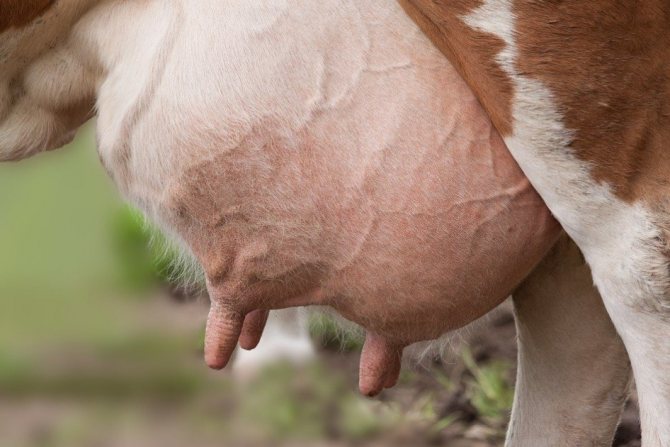
the udders are washed with clean warm water or a special solution, and the stalls are cleaned.
It is not recommended to wash the udder with cold or too hot water, as this will slow down milk production. At the same time the udder is massaged to prepare it for machine milking. To do this, stroke the udder with your fingers in a circular motion, slightly pushing up individual lobes of the udder, as a calf does when suckling.
The operation of preparing for machine milking must be carried out very carefully, accurately and quickly. During this time, the milk ejection reflex will occur, and you can start milking.
The productivity of cows depends not only on housing and feeding conditions, but also on the breed - Kholmogory, Shorthorn, Brown Latvian, Yaroslavl, Highland, Kazakh Whitehead, Kalmyk, Red Steppe, Black and White, Aberdeen Angus, Jersey, Ayrshire, Holstein, Dutch , Simmental - have completely different characteristics.
Having previously opened the vacuum valve of the milking machine, you need to put on the milking cups immediately after preparing the udder. The milkmaid should take the collector from below with one hand, bring it to the udder, with the other hand she should alternately put the milking cups on the teats, starting with the rear ones.
If necessary, the milkmaid uses her index finger and thumb to guide the teats into the milking cups. If it is necessary to lift the teat cup up, you must first clamp the milk tube.
The glasses should fit tightly to the nipples; there should be no hissing of air when the machine is running. Move to the next cow only after you have put on the teat cups correctly and milking has begun.
Milking control is carried out through a transparent teat cup cone or transparent milk hoses. If for some reason the milking slows down or stops, it is necessary, without removing the equipment, to massage the udder before resuming the process.
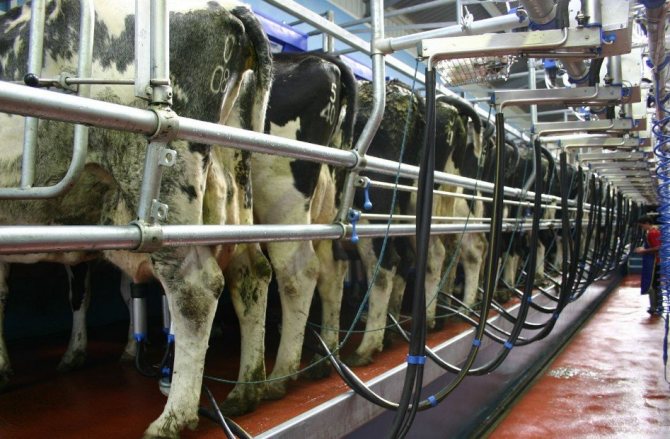
If the milking cups fall off the teats, turn off the machine, rinse the cups with clean water, massage the udder and put them on the udder again. To prevent the cow from knocking over the machine, it should be placed closer to the animal's front hooves.
If cows are accustomed to machine milking, they are milked quickly and do not require hand milking. It must be done according to a signal from the device, which is found on some types of machines, and after milking has stopped.
To finish milking a cow, the milkmaid takes the collector with one hand and pulls it along with the milking cups down and forward. The (final) massage of the udder is carried out with the other hand. The energy and duration of the massage depend on the individual characteristics of the cow.
To properly remove the teat cups, grasp the collector or milk tubes with one hand and squeeze them. Another is to close the valve on the manifold or the clamp on the hose. After this, the rubber suction cup of the glass is pressed away from the nipple with your finger to let air in, at the same time you need to smoothly remove all the glasses. Then connect the collector to a vacuum and suck out the remaining milk in the milking cups.
Important! After milking, the cow's nipples must be wiped with a clean, dry towel and lubricated with Vaseline or an emulsion that has an antiseptic effect.
After the process, milking machines are washed with warm water using a vacuum; first water is passed through the machine, and then a disinfectant. Washed milking machines are stored in a specially designated room.
Milking machine piston type "Dairy Farm", model 1P. Russia.
The milking machine "Dairy Farm" model 1P is a piston-type milking machine that has long established itself as a high-quality and reliable milking machine that combines simplicity, convenience and practicality of use. This device is widely used for machine milking of cows in private households and small livestock farms. The "Dairy Farm" milking machine is easy to use; no effort is required to ensure the operation of the machine. Low price and easily replaceable parts have made the Dairy Farm milking machine a reliable assistant for farmers.
Thanks to the use of a piston pump, there was no need for a pulsator and other components, which simplified the design of the milking machine and reduced its cost. The piston pump made it possible to make the milking process as comfortable as possible for the cows - milk suction imitates the sucking of a calf, which has a good effect on milk production and the attitude of cows to the milking process. Silicone is durable and safe for the skin of the nipples, it provides comfortable milking and significantly extends the service life.
| Performance | 8 – 10 cows per hour |
| Rated voltage | 220 V |
| Power consumption | 550 W |
| Working vacuum pressure | 40 – 50 kPa |
| Pulse frequency | 64 times/min |
| Can volume | 22.6 l |
| Length | 1000 mm |
| Width | 390 mm |
| Height | 780 mm |
| Weight without packaging | 47 kg |
| Guarantee | 12 months |
Design, principle of operation and operation
milking machine "Dairy farm"
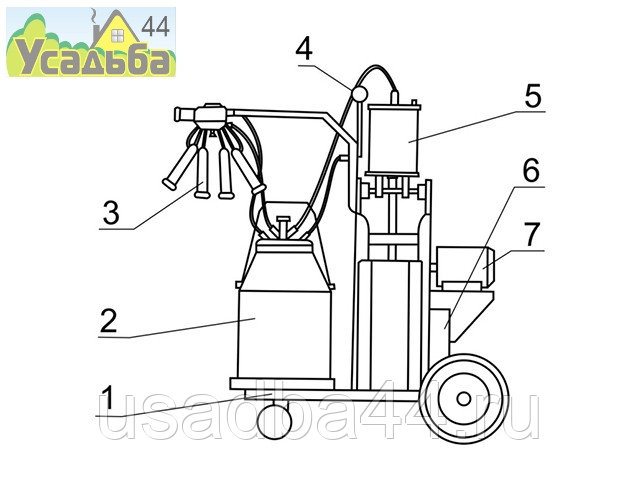
Milking machine components:
- Apparatus frame,
- Stainless steel milk can,
- Milking equipment,
- Vacuum gauge,
- Piston vacuum pump,
- Gearbox and transmission mechanism,
- Electric motor.
Operating principle of the milking machine "Dairy farm"
The milk can has a removable lid. In the center of the can lid there is a tee with a valve, inside of which there is a steel ball with a diameter of 11 mm. The upper tube of the tee is closed with an O-ring and a plastic limit screw. The side tube of the tee with a diameter of 14 mm is connected to the pipe on the cover of the vacuum pump. The side tube of the tee with a diameter of 9 mm is connected to a long air duct that creates pulsation in the milking equipment. In addition to the tee valve, there are two more tubes on the can lid. A tube with a diameter of 19 mm is the inlet of the milk line, which is connected by a hose to the outlet of the milk receiver of the milking equipment. A tube with a diameter of 9 mm is connected by a hose to a vacuum gauge.
The milking equipment consists of a milk receiver, a vacuum regulator and four glasses. The glass consists of a body made of stainless steel, external and internal nipple rubber, a milk pipe and a vacuum pipe. A corrector screw is installed at the end of the milk receiver to adjust the amount of vacuum in the milking equipment. The milk receiver is connected to the teat cups using milk pipes that have transparent inserts to control the milking process. The pulsation is supplied to the milking cups through vacuum pipes, which are connected through a splitter with a long hose to a tee on the can lid. Incorrect connections of the pipes in the milking equipment will lead to improper operation of the milking unit; pay attention to the correct assembly and tightness of the connections. A piston vacuum pump is composed of a cover, a housing, a pump foot, a piston (consisting of a base, an elastic spring, a cowhide cup and a pressure nut), an outer connecting rod, a horizontal axis, a rod, a crank, etc. The cover and base of the pump are cast from aluminum, the body is a plastic pipe. The main working element of the piston is a cup made of cowhide, inside of which a spring is installed to ensure a tight fit of the piston to the walls of the pump housing. To ensure a minimum coefficient of friction between the piston and the body and achieve better tightness of the system during operation, it is necessary to periodically lubricate the leather part of the piston with oil. The structure of the pump is shown in the installation diagram. The pump is driven by an electric motor. The engine is connected through a belt drive to a gearbox, which drives the crank rod, providing reciprocating movement of the piston. The gear ratio of the large and small gears of the gearbox provides the necessary speed at which the pulsation frequency reaches 64 times per minute. On the side of the gearbox housing there is an oil filling hole, closed with a bolt. The emergence of a vacuum. The pump piston performs reciprocating movements in the pump housing; when the housing moves downward, a vacuum is created; when it moves up, the ball valve in the pump cover opens and air from the system escapes into the atmosphere. These two movements form a pulsation in the milking equipment.
The milking machine operation process
Milking. When the piston moves down, the ball valve on the pump is closed, and the ball valve on the can lid is open, a vacuum is formed in the closed can and the milking equipment. The same pressure in the inner body and in the chamber between the inner and outer body of the glass ensures that the inner body of the glass opens and milk is sucked out of the nipple. The milk enters the milk receiver and is sucked into the can.
Rest. When the piston moves up, the ball valve on the pump cover is open and the valve on the can cover is closed. At this time, air enters the chamber between the outer body of the glass and the liner, and a vacuum is formed in the closed can and the internal space of the glass. A pressure difference arises inside the glass and in the chamber between the outer housing and the glass liner. The pressure difference ensures that the insert closes and the flow of milk stops. During the milking process, the vacuum value on the vacuum gauge should be 0.04 - 0.045 MPa.
Safety precautions when working with the Milk Farm milking machine • Installation of electrical wiring and connections must be carried out by a qualified specialist. It is recommended to equip the electrical network of the premises to which the product is connected with a residual current device. • Perform repairs and maintenance of the milking unit only after disconnecting the unit from the electrical network.
Operation of the milking machine • After turning on the unit, it is necessary to position the milking equipment so that the metal vacuum splitter for pulsation is higher than the milk receiver. After a minute, the vacuum value on the vacuum gauge should reach 0.04-0.045 MPa. If the vacuum value is too high or low, it is necessary to correct it using the control valve on the milk receiver to a value of 0.04-0.045 MPa. • Before you start milking, you need to wash the udder with warm water and massage it 2-3 times, squeezing each nipple with your hand, then you can install the milking cups and start milking. • To connect the milking equipment, stand on the side of the cow, hold the milk receiver with one hand so that the vacuum pipes and their metal splitter are on top and the glasses hang down freely. With your other hand, you must quickly place the glasses on the nipples one by one. During the operation, it is better to hold the milk pipe of the cup with an S-bend to prevent the atmosphere from entering the cup. • Milking should take place under a stable vacuum, watch the numbers on the vacuum gauge. At this time, observe the flow of milk through the transparent parts of the milk pipes. At the end of milking, the operator can manually press down on the milk receiver to improve the milking process. • Then, holding the milk receiver with one hand, you need to release the vacuum by unscrewing the vacuum regulator so that the milking cups can be easily removed from the udder. Then you need to treat the nipples with a disinfectant liquid. • After removing the milking equipment, hang it by the hook on the handle of the milking machine, open the lid of the can, pour in the milk and you can start milking the next cow.
Cleaning and disinfection of the milking machine • After finishing milking, it is necessary to close the lid of the can and wash off the dirt from the milking equipment with clean water. Place the cleaned equipment in a bucket of hot water or disinfectant liquid and start the vacuum unit. Rinse the milking equipment, hoses and can in this way several times, and finally rinse everything with clean water to wash off any remaining disinfectant liquid. • A week after using the milking machine, it is necessary to dismantle the milk receiver, can and set of glasses. Use the brush supplied with all Dairy Farm milking machines to completely clean them. Repeat this operation weekly.
Inspection, maintenance and repair of the milking machine “Dairy Farm” • Every 750 hours of operation of the vacuum unit, it is necessary to replace the lubricating oil in the gearbox (0.4 kg of nigrol No. 40) • Every week it is necessary to disassemble the vacuum pump, stretch the leather piston bowl and lubricate it with oil, for reducing friction and improving pump sealing. When assembling, pay attention to the correct installation of the gasket between the pump body and the cover. • To increase the service life of the nipple rubber, it is advisable to change the set of liners once a month. After degreasing and drying the exchange set of liners, store it in the shade so that the rubber is in good condition. After a month, replace the liner sets again. Before installing them, you need to make sure there are no cracks, deformations or other damage on the rubber. If these phenomena are detected, it is necessary to replace the kit with a new one. • Periodically inspect hoses and other rubber parts of the unit; if cracks are found, replace these parts.
Follow the rules of machine milking.
